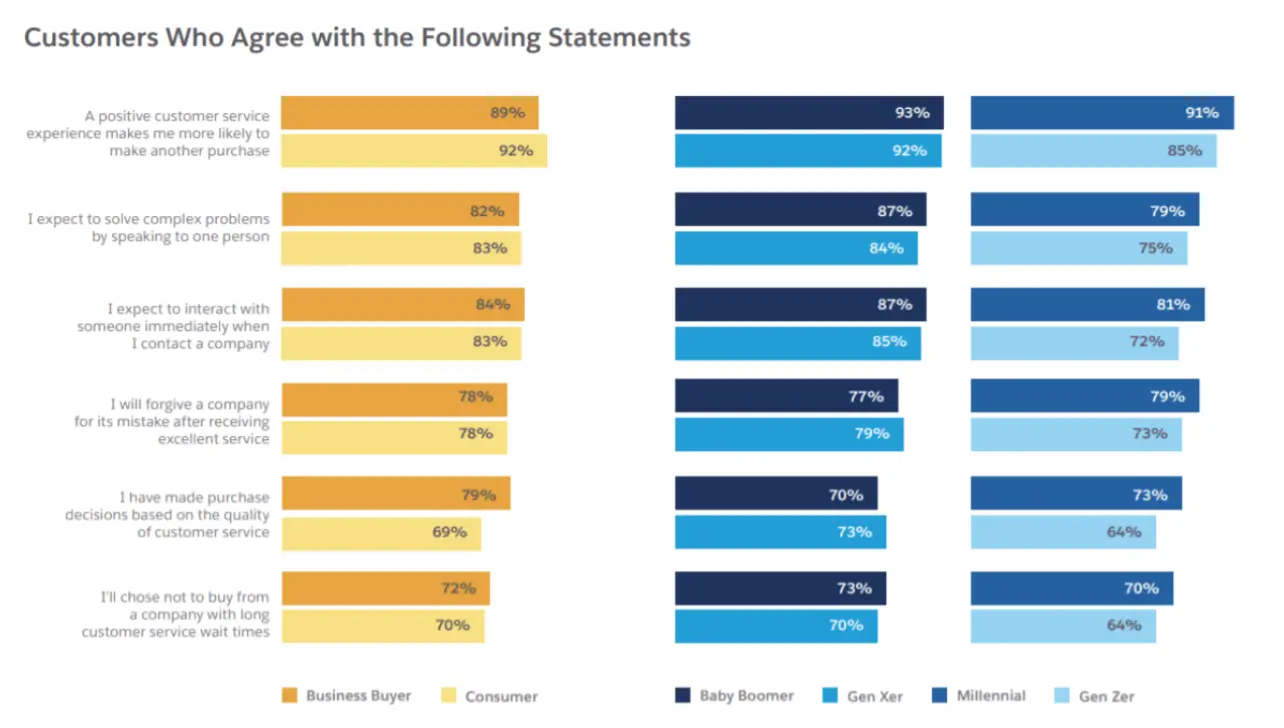1. What is the post-purchase experience?
Post-purchase experience refers to customers’ behavior after they purchased the product.
Most brands overlook the importance of the post-purchase experience and fail to keep the customer engaged once they complete the purchase process.
In this phase, customers often feel post-purchase dissonance, where they doubt their decision and regret buying the product.
It happens due to an excessive offers on the market and customers’ fear of making the wrong choice.
Brands need to recognize this phrase and leverage it to deliver the best post-purchase experience.
To do so, they need to assure the customers about their decision. They can educate them about the product they purchased and show them the product benefits.
In this way, they keep customers engaged even after the purchase, which is often the main element for turning prospects into long-term customers.
Although most brands still fail to recognize the importance of optimizing the post-purchase experience, there are numerous reasons for them to start doing it now.
1.1. Why does the post-purchase experience matter?
According to Salesforce’s research, 89% of consumers will most likely make another purchase if a brand delivers an excellent customer service experience.
But post-purchase experience is not strictly limited to customer service; it is a well-planned strategy that, if done well, can bring a lot of benefits.
 Image source: Screenshot taken by the author via Salesforce
Image source: Screenshot taken by the author via Salesforce
1.1.1. It helps you build a stronger customer relationship
According to Support, more than 40% of consumers claim that the post-purchase experience is the main thing that makes the brand memorable.
In this phase of the customer’s journey, the most important thing is to show you care. Optimizing your post-purchase experience is the opportunity to build a long-lasting relationship with your customer and reach customer loyalty.
1.1.2. Improve brand’s reputation
The power of word of mouth is vital for every successful business, and 92% of customers have reported that they trust the purchase recommendation from their friends and family.
Providing an outstanding post-purchase experience, you show that you care and give your customers a reason to stay. After that, they will serve as brand ambassadors by sharing a positive experience with your brand.
1.1.3. Increase customer retention
The majority of brands focus on driving new sales and finding new customers. The truth is that finding new customers costs five times more than retaining an existing customer.
Nowadays, brands focus on developing post-purchase strategies that will help keep customers. By doing this, brands can increase their revenue by between 25% and 95%.
2. 5 ways to improve your post-purchase experience
- Personalize the approach of the post-purchase experience
- Provide a seamless product return process
- Offer How-to guides and Product care tips
- Service satisfaction feedback
- Loyalty programs
2.1. Personalize the approach of the post-purchase experience
According to research from Salesforce, 75% of customers expect the companies they buy from to deliver personalized experiences, anticipate their individual needs, and provide product recommendations.
Personalizing the post-purchase experience, your customers see that you understand the why behind each purchase and that you can offer a solution.
If you are looking to optimize your personalized approach to the post-purchase cycle, here are some things you can do:
2.1.1. Enhance the delivery experience by personalizing the packaging
Over 50% of customers reported they would prefer to buy from a brand that uses customized packaging.
Brands often overlook the importance of product presentation in the delivery stage because the customer has already completed the action most brands are striving for - the purchase.
However, investing in branded packaging can improve customer experience because it will make them excited to receive an order and are more likely to turn in loyal customers.
2.1.2. Personalize Feedback Request
Another way to optimize your post-purchase experience is getting a better insight into what your customers think about your products. It doesn’t mean sending them a generic email to complete a survey; you should go the extra mile to make it more personal.
One great example is an Australian jewelry brand Bellroy which sends a personalized email 30 days after purchase. It allows customers to use the item for several weeks before providing feedback.
Bellroy also personalizes feedback requests. Rather than simply asking the customer if they are satisfied with the purchase, they address the actual item they purchased. With this, they show they pay attention to their customers.
2.1.3. Personalize product recommendation
Collecting as much information about your customer as possible will make it easier for you to predict their next purchase and build a better relationship with them.
There are several methods that can be used to collect customer data, for example, social media monitoring, information from registration, and subscription data.
Despite having limited information, you can anticipate their needs by looking at the item they purchased from you.
Once you have this information, you can send an email with similar product recommendations.
Amazon did a great job with its recommendation system, offering various recommendations. One of them is your recommendation, as shown in the example below.
Image source: Screenshot taken by the author via Amazon
2.2. Provide a seamless product return process
Over 92% of customers say that they will use the brand’s service again if the return process is smooth and easy.
Once customers complete the purchase, they can feel anxious if they made the right decision and what happens if something goes wrong.
You want to be one step ahead and be transparent about your refund and return policy. In this way, you show your customers that you are also interested in their needs, not only about the sales.
If a customer wants to return the product, there is no need for brands to worry. Instead, they should use the return or exchange as the opportunity to build customer loyalty. If their customers are satisfied, they will eventually become loyal customers who regularly buy their products.
2.3. Offer How-to guides and Product care tips
When a customer purchases the product, it doesn’t mean they are 100% sure how to use it.
Focus on educating your customers about using your products to ensure customer satisfaction and improve your post-sales experience.
In most cases, how-to guides and demos can help in this stage.
Brands should use their blogs for publishing user guides to tell customers how to use their products. They can even film demos to talk about the product’s features. It is beneficial to highlight the most important features that customers often use.
Another way to do it is to send emails with infographics, along with a thank you note or personalized feedback request.
NJORD provided the minimalist style guide for its customers to provide valuable information on everything customers need to know about using the brand's logo and color palette for both web and print.
Image source: Screenshot taken by the author via Behance
2.4. Service satisfaction feedback
Asking your customers for feedback is a great way to boost customer experience and build trust.
You let customers know that their opinion is important to you by asking them to provide feedback. Moreover, you can understand the trouble customers might face when using the product when you see it from their perspective.
Timing plays a vital role in this part. Depending on what type of product the customer purchased, you will send emails at different times.
For one term service like Uber, you can send the email right away. People are likely to provide feedback straight away. For technology items or makeup, it might take some time. They need to try it out before they can give feedback.
Image Source: Really Good Mails
2.5. Loyalty programs
To improve the post-purchase experience, brands should stand out from others in the market and go beyond a simple thank you.
Utilizing loyalty programs can help build an emotional relationship with customers and build their loyalty. Brands show customers they are appreciated and that brands care about their satisfaction.
One way to build a loyalty program is to allow exclusive benefits like discounts or free-of-charge shipping for customers who join your VIP club. Customers can pay a monthly or annual fee to join, and in return, they get discounts or other benefits.
The North Face offers an XPLR PASS loyalty offer, and customers get 10% off their first online purchase. It doesn’t end with that; The North Face promises more benefits after they are members.
Image source: Screenshot taken by the author via The North Face
3. Final Thoughts
It is often a case that brands disregard the importance of post-purchase experience and focus on attaining new customers.
Overlooking its importance can harm your marketing budget and cost you the opportunity to convert prospects into loyal customers.
By optimizing the post-purchase experience, you can get long-term customers who will serve as brand advocates and help you build a positive brand reputation.
Feel free to try out the ideas from the article to build a solid community of satisfied and loyal customers.
Author Bio:
Mitko Ivandjikov is a professional outreach specialist at Intercoolstudio, working with the team to increase their visibility and grow their customer base. He’s also an avid sports fan who spends his free time watching, reading about, or playing basketball.

